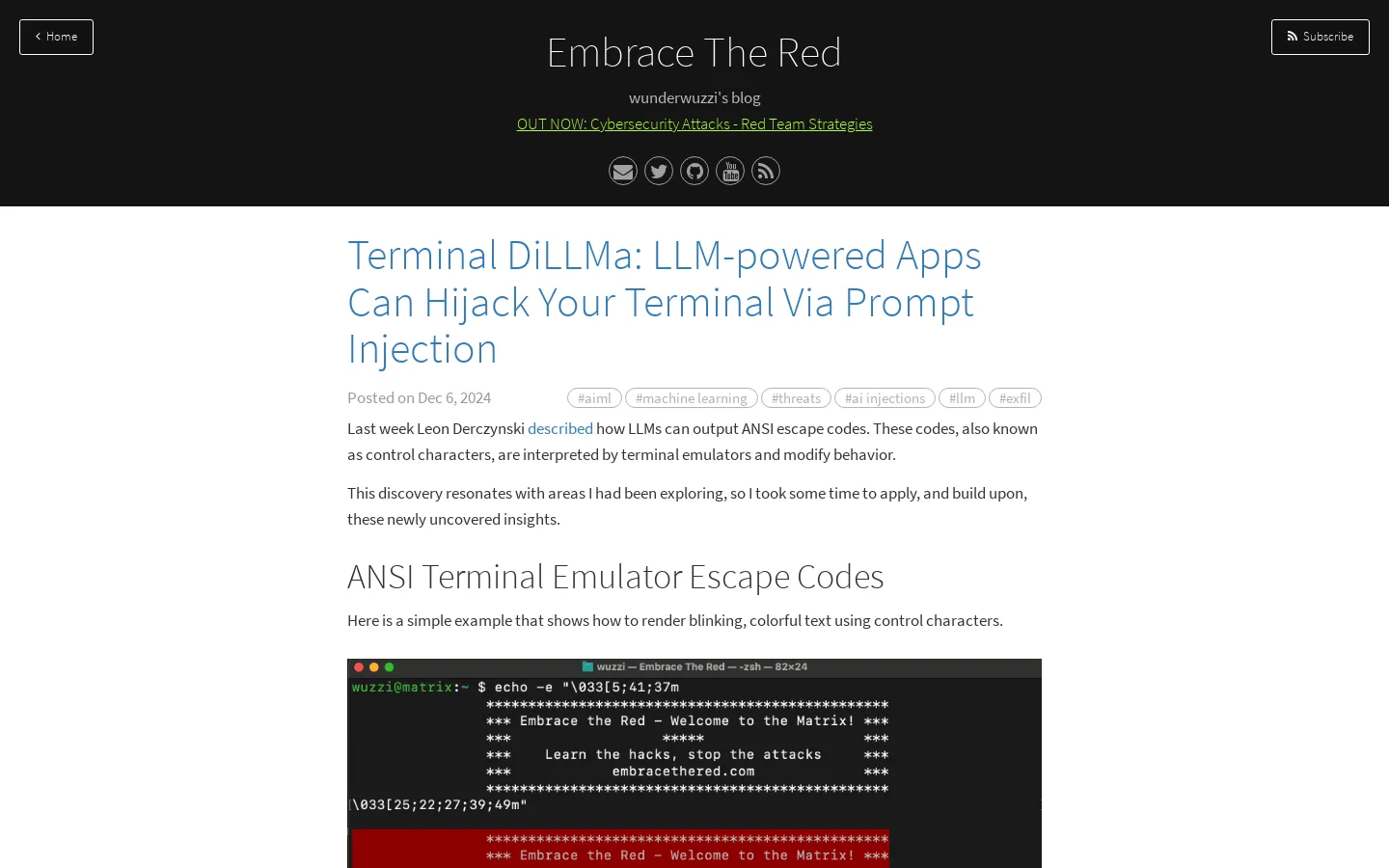
Security Risks of ANSI Escape Codes in Terminal Emulators
/ 4 min read
Quick take - A recent tutorial on ANSI escape codes explored their functionality in terminal emulators, highlighted associated security vulnerabilities, particularly regarding remote code execution and denial of service attacks, and examined the implications of large language models in generating and interpreting these codes, while proposing mitigation strategies for developers and security professionals.
Fast Facts
-
ANSI Escape Codes Functionality: These codes control text formatting in terminal emulators, enabling features like color changes and cursor movement, which enhance user interfaces but require careful handling to avoid misuse.
-
Security Vulnerabilities: The tutorial emphasizes risks such as remote code execution (RCE) and denial of service (DoS) attacks that can arise from exploiting ANSI escape codes, highlighting the need for vigilance in their use.
-
LLM Interactions: Large language models (LLMs) can generate and interpret ANSI codes, presenting both innovative application opportunities and new security challenges that must be managed effectively.
-
Testing and Mitigation: The tutorial advocates for testing prompt injection scenarios and implementing mitigation strategies, such as output encoding and allow-listing, to safeguard applications against potential vulnerabilities.
-
Ongoing Education: Continuous learning and proactive security measures are essential for developers and security professionals to effectively utilize ANSI escape codes while minimizing risks in terminal environments.
Understanding ANSI Escape Codes and Their Security Implications
A recent tutorial has brought to light the intricate world of ANSI escape codes, their functionalities within terminal emulators, and the security vulnerabilities they pose. This exploration also delves into the role of large language models (LLMs) in generating and interpreting these codes, highlighting both opportunities and risks.
The Basics of ANSI Escape Codes
ANSI escape codes are sequences of characters that control text formatting in terminal emulators. They enable functionalities such as changing text color, moving the cursor, and altering display attributes. While these capabilities enhance user interfaces, they also require a thorough understanding to prevent misuse.
Security Vulnerabilities Uncovered
The tutorial emphasized significant security risks associated with ANSI escape codes. Vulnerabilities such as remote code execution (RCE) and denial of service (DoS) attacks can occur when malicious actors exploit these codes to manipulate terminal behavior. Such exploits can lead to unauthorized system access or service disruptions.
LLMs and ANSI Escape Codes: A Complex Interaction
A key focus of the tutorial was the interaction between LLMs and ANSI escape codes. These models can generate and interpret ANSI codes, which raises important considerations for security and application design. While LLMs offer innovative applications, they also introduce new attack vectors if not properly managed.
Testing and Mitigation Strategies
To address these security concerns, the tutorial presented various test cases exploring prompt injection attacks using ANSI escape codes. It also proposed mitigation strategies to secure applications against these vulnerabilities, underscoring the importance of robust security measures in development.
Key Steps for Developers
1. Understanding ANSI Escape Codes
Developers must first gain a solid grasp of ANSI escape codes to leverage their capabilities effectively with LLMs. Familiarity with these codes is crucial for creating dynamic text outputs while maintaining security.
2. Exploring LLM Capabilities
Once familiar with ANSI codes, developers should explore how LLMs can interpret and generate these codes. Experimenting with different prompts can reveal the model’s strengths and limitations in handling such formatting.
3. Testing Prompt Injection Scenarios
Testing various prompt injection scenarios is essential to identify potential vulnerabilities or unexpected outcomes in LLM behavior. This step is crucial for robust application development.
4. Implementing Mitigation Strategies
Effective mitigation strategies should be implemented based on testing findings. This includes refining prompts to prevent unintended effects or employing filters to sanitize user inputs before processing.
Best Practices for Terminal Security
Understand ANSI Escape Codes
Familiarize yourself with the syntax and available commands to create more dynamic outputs while preventing misuse.
Implement Output Encoding
Ensure that any output generated by applications is properly encoded to safeguard against injection attacks and maintain data integrity.
Conduct Thorough Testing
Regular testing under various conditions helps identify issues related to output rendering and performance, ensuring expected behavior across environments.
Utilize Allow-Listing
Define a strict list of acceptable inputs and outputs to mitigate unauthorized command execution risks, maintaining a controlled environment for trusted actions.
Tools and Resources for Enhanced Security
-
David Leadbeater’s DEF CON 31 Talk: Explores the historical evolution of ANSI escape codes and their impact on terminal security.
-
STÖK’s Ekoparty Talk: Analyzes potential misuse of ANSI escape sequences in text inputs, highlighting forensic challenges.
-
dillma.py - A Demo Application: Demonstrates functionalities of ANSI escape codes within terminal environments.
-
Caret Notation Encoding Functions (Python and Go): Provides structured encoding/decoding functions to mitigate security risks associated with ANSI codes.
These resources equip developers and security experts with knowledge and tools necessary to navigate terminal security complexities in the age of LLMs. By integrating best practices into workflows, developers can enhance both functionality and security in projects involving ANSI escape codes and terminal interactions.



